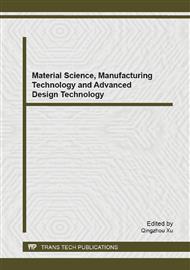[1]
Aresta M. Carbon dioxide as Chemical Feedstock. Wiley; (2010).
Google Scholar
[2]
Darensbourg DJ. Chemistry of carbon dioxide relevant to its utilization: a personal perspective. Inorganic Chemistry, 2010 Oct 25; 49(23): 10765–80.
DOI: 10.1021/ic101800d
Google Scholar
[3]
Luinstra GA. Poly (propylene carbonate), old copolymers of propylene oxide and carbon dioxide with new interests: catalysis and material properties. Polymer Reviews, 2008 Feb 1; 48(1): 192–219.
DOI: 10.1080/15583720701834240
Google Scholar
[4]
Qin Y, Wang X. Carbon dioxide-based copolymers: environmental benefits of PPC, an industrially viable catalyst. Biotechnology Journal, 2010; 5(11): 1164–80.
DOI: 10.1002/biot.201000134
Google Scholar
[5]
Inoue S, Koinuma H, Tsuruta T. Copolymerization of carbon dioxide and epoxide. Journal of Polymer Science Part B: Polymer Letters , 1969; 7(4): 287–92.
DOI: 10.1002/pol.1969.110070408
Google Scholar
[6]
J. Gao, H.W. Bai, Q. Zhang, Y. Gao, L. Chen, Q. Fu, Effect of homopolymer poly(vinyl acetate) on compatibility and mechanical properties of poly(propylene carbonate)/poly(lactic acid) blends, EXPRESS Polymer Letters, 6 (2012) 860-870.
DOI: 10.3144/expresspolymlett.2012.92
Google Scholar
[7]
J. Gao, F. Chen, K. Wang, H. Deng, Q. Zhang, H.W. Bai, Q. Fu, A promising alternative to conventional polyethylene with poly(propylene carbonate) reinforced by graphene oxide nanosheets, Journal of Materials Chemistry, 21 (2011)17627-17630.
DOI: 10.1039/c1jm14300j
Google Scholar
[8]
T. Yu, Y. Zhou, Y. Zhao, K.P. Liu, E.Q. Chen, D.J. Wang, F.S. Wang, Hydrogen-Bonded Thermostable Liquid Crystalline Complex Formed by Biodegradable Polymer and Amphiphilic Molecules, Macromolecules, 41 (2008) 3175–3180.
DOI: 10.1021/ma7020562
Google Scholar
[9]
G.H. Yang, J.J. Su, J. Gao, X. Hu, C.Z. Geng, Q. Fu, Fabrication of well-controlled porous foams of grapheme oxide modified poly(propylene-carbonate) using supercritical carbon dioxide and its potential tissue engineering applications, The Journal of Supercritical Fluids, 73 (2013).
DOI: 10.1016/j.supflu.2012.11.004
Google Scholar
[10]
X. Zhong, Z.F. Lu, P. Valtchev, H. Wei, H. Zreiqat, F. Dehghani, Surface modification of poly (propylene carbonate) by aminolysis and layer-by-layer assembly for enhanced cytocompatibility, Colloids and Surfaces B: Biointerfaces, 93 (2012) 75-84.
DOI: 10.1016/j.colsurfb.2011.12.016
Google Scholar


